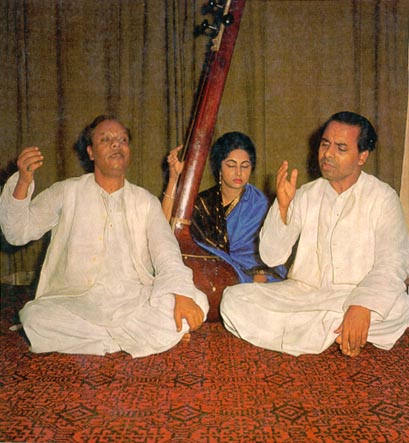|
The
Classical Music of North India
The Dhrupad Tradition

About Dhrupad
The
Dhrupad style of performing instrumental and vocal music
is the oldest style of North Indian classical music performance.
Dhrupad is an ancient spiritual music art form that was
performed in the temples and the courts during medieval times. A
form of
yoga, this powerful and important musical style is nearly extinct in
the world, only a few Indian musicians bringing it into this
century.
Classical music in India took to the concert halls instead of
the courts and temples and became less connected to its
spiritual roots. During the 18th Century, the Dhrupad style it
was gradually replaced by the lighter kheyal (meaning
imagination) style. Today, many devoted followers of North Indian
classical music consider Dhrupad to be boring, monotonous and
archaic. Nothing could be further from the truth for a listener
able to connect with the essence of this important, ancient art.
The
difference between Dhrupad and the more modern forms of Indian
classical music is that Dhrupad is very slow and majestic. Its
compositions are made up of four sections instead of the more
modern two, and they are composed of very even note values. In
vocal music, Dhrupad singing is different from the more recent
keyal style of singing in that keyal singing is accompanied
by either the sarangi stringed instrument or the more
modern, and deplorable, harmonium keyboard. In the
Dhurpad style, ragas are performed by either vocalists or
instrumentalists who perform using an older instrument called the vina--a
long stringed instrument that has a gourd on each end. The drum that
accompanies Dhrupad is the pakhawaj, a cousin to the
South Indian miradungam. The pakhawaj is played horizontally
and has a head at each end. It was the precursor of the tabla which
is like a pakhawaj split into to halves and each placed
upright. The styles of keyal and dhrupad are different
also. Dhrupad is more formal and certain liberties, such as
the singing of melodic patterns called taans, are not
allowed in Dhrupad.
As
we stated, Dhrupad
was replaced in vocal music by a lighter style of music called kheyal,
a beautiful type of music prevalent in the vocal tradition
of the 20th Century. Keyal is usually less stately and majestic
and can be used to express moods a lot lighter than dhrupad,
however it can be very majestic, similarly to dhrupad and some
of the more profound singers of the last century sang keyels in
a manner that was similar to a dhrupad alap. In instrumental
music, a form of playing called alap/gat has replaced dhupad.
The first section of a performance is a performance of what is
called an alap: the slow, solo unveiling of the raga.
After this section, the gat, the musical composition
elaborated by improvisation, is performed. The alap is derived
from dhrupad where the alap serves as the first part of
traditional dhrupad raga performances. Dhrupad lives on in the
instrumental alap, however only a handful of contemporary
instrumental performers learn and base their alap compositions
in the correct principals of dhrupad performance.
|
Smt.
Gangubai Hangal on Dhrupad Music
"I
feel that a base of Dhrupad is absolutely essential for
any student of music. It helps the student to have a
complete grasp over the notes and voice culture. I have
had rigorous training in the Dhrupad style, which was a
must for a student of Dhrupad in our time. I remember
learning Dhrupad which did not only improve my sur
gyan, but also helped in perfecting my sense of taal.
I owe a lot of my understanding of music to my basic
training in this form. However, while accepting its
undoubted strengths, I found it limited in that a lot of
liberties which are allowed in khayal, and which I
enjoy, like taans are taboo in the Dhrupad style.
Dhrupad, all in all is a great music tradition which
must be kept alive." |
|

